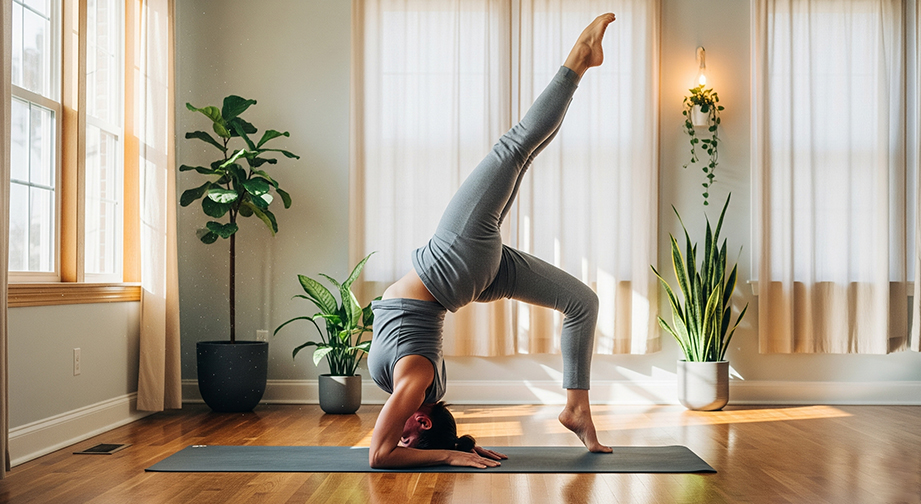Viparita Dandasana (Inverted Staff Pose): Step-by-Step Guide, Benefits, and Tips
Introduction
Looking for a deep, juicy backbend that invigorates your whole body? Viparita Dandasana, or the Inverted Staff Pose, might become your new favorite yoga asana.
In Sanskrit, "Viparita" means "inverted" and "Danda" means "staff", referring to the straight, strong shape of your body while inverted. The essence of this pose is energizing and opening—it wakes up your heart, stretches your front body, and builds confidence as you go upside down.
Not sure if you’re ready for such a powerful backbend? If you’ve ever felt the need to shake off stiffness from long hours at your desk, Viparita Dandasana can offer a profound release and recharge for both body and mind.
Step-by-Step Guide: How to Practice Viparita Dandasana

- Start in Bridge Pose (Setu Bandhasana):
Lie on your back, knees bent, feet hip-width. Place your arms alongside your body.
- Move into Upward Bow (Urdhva Dhanurasana):
Place your palms beside your ears, fingers pointing toward your shoulders. On an inhale, press firmly into your hands and feet, lift your hips and chest toward the ceiling, straightening your arms.
- Find Your Forearms:
As you exhale, gently lower the crown of your head to the mat. Bring your forearms down one at a time, so your elbows are shoulder-width apart and forearms press into the ground, much like a supported backbend.
- Straighten Your Legs:
On your next inhale, walk your feet forward the mat until your legs are straight, toes pointing up. Your head is lightly on the ground, weight in your forearms and feet.
- Breathe Mindfully:
Keep your breath steady—a slow inhale as you root shoulders and forearms, a gentle exhale as you lift through your heart and hips. Your gaze can softly rest backward or through closed eyes.
- To Release:
After a few breaths, walk your feet back, bring your hands under your shoulders, gently lift the head, and slowly lower down to the mat on an exhale. Rest in Savasana or a gentle spinal twist.
Duration: Hold for 5–10 slow breaths (20–40 seconds). Repeat 1–2 rounds, resting between.
Modifications & Variations
- Beginners: Place a yoga block or bolster under your upper back for support, or practice legs-bent (feet close to hips) instead of straightening the legs fully.
- Advanced: Try lifting one leg at a time, or interlace hands behind your head. Some may even transition to Chakrasana (Wheel Pose) or drop back from headstand for a challenge!
Alignment & Safety Tips
- Key cues: Elbows shoulder-width, strong forearm and hand press, chest open and spacious, engage core to protect lower back.
- Avoid common mistakes:
- Letting your elbows slide out—keep them parallel, not splayed.
- Dumping all weight onto your neck or head—root into forearms and feet.
- Collapsing into your lower back—draw the front ribs in and lengthen your tailbone.
- Safety first! Not for those with recent back, neck, or shoulder injuries, high blood pressure, pregnancy, or glaucoma. Always warm up thoroughly (try Bridge, Cobra, Bow).
Benefits of Viparita Dandasana (Inverted Staff Pose)
Physical Benefits
- Opens chest, shoulders, and hip flexors
- Improves spinal mobility and strengthens back muscles
- Lengthens the front body and improves posture
- Tones glutes, legs, and arms
Mental Benefits
- Refreshes the mind and combats fatigue
- Promotes stress release and emotional openness
- Invites mindfulness and present-moment awareness
Energy / Chakra Connection
- Stimulates Anahata Chakra (Heart center) for emotional balance
- Activates Manipura (Solar Plexus) for confidence and vitality
- Uplifting, energizing effect on entire energy system
Contraindications
- Pregnancy
- Serious back, neck, or shoulder injuries
- High or low blood pressure
- Recent abdominal surgery
- Glaucoma or serious eye conditions
Alternatives: Try supported Bridge Pose, Supta Baddha Konasana, or a gentle Fish Pose if Viparita Dandasana is not suitable for you.
Beginner’s Tips & Variations
- Props: Use a yoga block under your chest, a wall for leg support, or a bolster beneath your spine for extra comfort.
- Gentle Variation: Practice with knees bent and feet hip-width, rather than straightening the legs.
- Advanced Variation: Experiment with lifting one leg, or transitioning to and from Headstand or Wheel Pose if well-practiced.
How to Include Viparita Dandasana in Your Yoga Flow
Best as a peak or main practice pose, once warm and open. It’s great after Camel Pose, Bow Pose, or Bridge, and before cooling floor twists and Savasana.
- Pairs well with: Setu Bandhasana (Bridge), Ustrasana (Camel), Dhanurasana (Bow)
Mind-Body Connection
As you practice Viparita Dandasana, focus on the feeling of heart-opening and strength. Breathe deeply into any areas of tension, and notice the sense of lightness and expansion with each exhale. This posture is as much about inner courage as outer flexibility.
Chakra significance: Heart chakra (Anahata)—invite compassion, openness, and joy.
Summary Box
Asana Name: Viparita Dandasana (Inverted Staff Pose)
Level: Intermediate to Advanced
Focus Areas: Spine, chest, hamstrings, glutes, shoulders
Duration: 20–40 seconds (5–10 breaths), 1–2 rounds
Best Time to Practice: Morning or late afternoon, when fully warmed up
Frequently Asked Questions
Is Viparita Dandasana safe for beginners?
This pose is best practiced by intermediate or advanced yogis. Beginners should use props and guidance from an experienced teacher.
What do I do if I feel pain in my low back?
Come out of the pose right away. Pain usually means poor alignment or over-effort. Practice Bridge Pose or a supported Fish Pose as an alternative.
Can I use a wall for support?
Absolutely! Place your feet on a wall, or do the pose with a bolster under your back for extra steadiness.